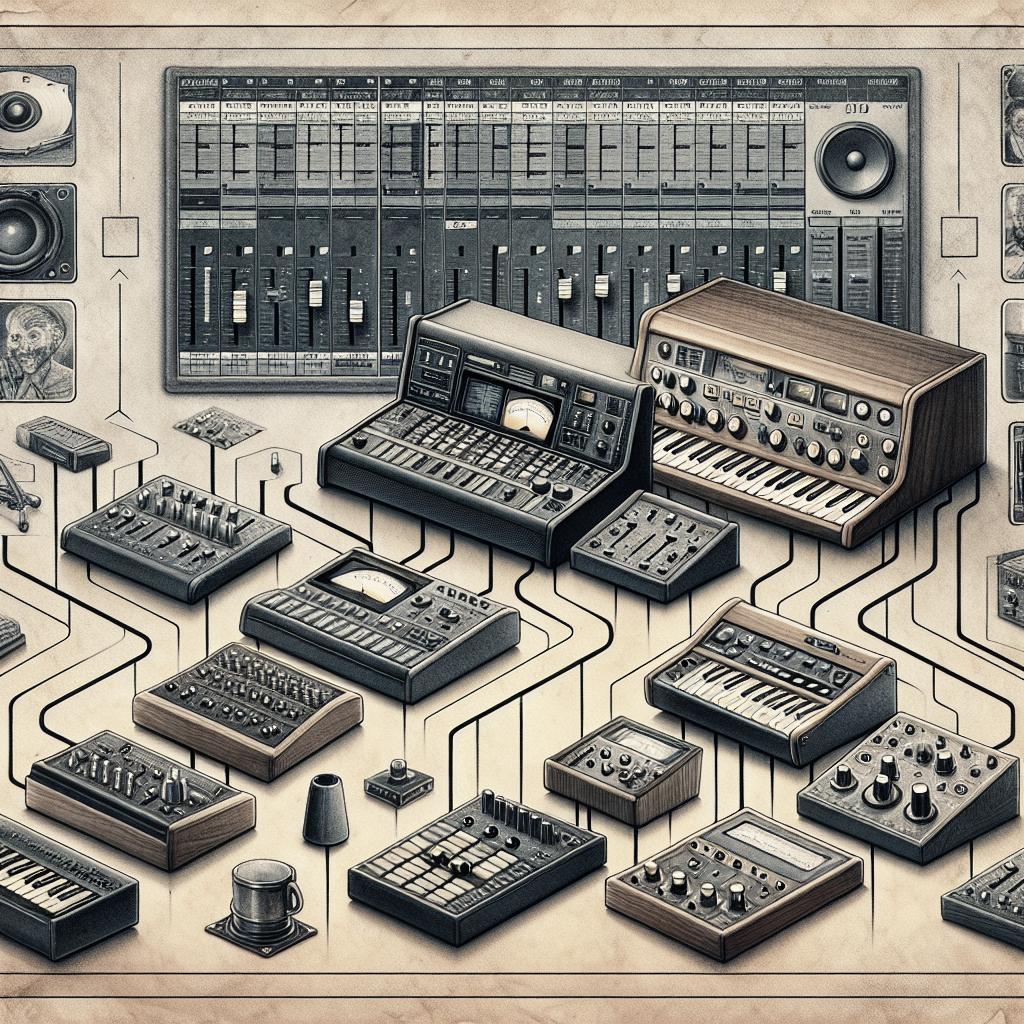“`html
The Ever-Evolving World of Digital Audio Workstations
Digital Audio Workstations (DAWs) have transformed the way we create and produce music. With a rich history rooted in technological innovation, these platforms have expanded from simple sequencers to comprehensive production suites. This blog post delves into the evolution of some of the most influential DAWs, highlighting milestones from Steinberg Cubase to Apple’s GarageBand. We’ll explore the advent of plugins, MIDI significance, and the blend of sequencer and DAW functionalities. As you journey through the pivotal moments in DAW history, you’ll gain insights into how past innovations continue to shape the future of music production.
The godfather of DAWs: Steinberg Cubase
Steinberg Cubase, often heralded as the godfather of DAWs, revolutionized music production when it was first released in 1989. This software brought advanced MIDI sequencing capabilities to the fingertips of musicians and producers, allowing unprecedented control over their compositions. Steinberg’s pioneering vision has continually driven the evolution of Cubase, ensuring it remains at the forefront of digital music production.
Cubase’s initial success lay in its user-friendly interface, which demystified the complexities of MIDI sequencing. Over the years, as recording technology advanced, Cubase integrated cutting-edge features like VST support and audio editing. These enhancements made it an invaluable tool for both amateur and professional musicians, paving the way for other DAWs to follow suit.
Highly logical: Emagic Logic
Emagic Logic, now known simply as Logic Pro, has been a staple in the music production industry since its inception. Acclaimed for its robust capabilities and exceptional sound quality, Logic has garnered a loyal following among musicians and producers worldwide. This powerful DAW offered groundbreaking MIDI sequencing and audio editing capabilities that set new standards in the industry.
Under Apple’s ownership, Logic Pro has been continually refined, embracing an intuitive user experience while expanding its feature set. Logic’s adaptability and relentless pursuit of innovation have ensured its position as one of the top DAWs for music production and composition today.
From live looping to studio staple: Ableton Live
Ableton Live made waves with its introduction to the market, primarily due to its revolutionary approach to music production. Designed with live performances in mind, Live offered an intuitive and flexible solution for musicians who wanted to integrate digital tools into their sets seamlessly. Its unique Session View provided a nonlinear method for arranging and triggering musical ideas, which quickly became popular among live performers and DJs.
As Live evolved, it transformed from a performance tool into a comprehensive production suite. Ableton’s dedication to innovation has consistently pushed the boundaries of music creation, making it a staple in studios worldwide. Its ability to merge live performance with studio production has empowered musicians and producers to reimagine how they create and share music.
High performer
High-performance DAWs are defined by their ability to handle demanding audio processing tasks with efficiency and precision. These DAWs offer advanced audio engines, low-latency performance, and robust MIDI sequencing capabilities, providing musicians with an unparalleled production experience.
As technology evolved, DAWs needed to accommodate more intricate compositions and larger session files. The rise of multi-core processors and increased RAM capacity has enabled DAWs to deliver exceptional performance, even in complex projects. This evolution has allowed artists to explore new creative horizons without limitations.
Non-linear thinking
Non-linear DAWs introduced a paradigm shift in music production, freeing artists from the constraints of traditional linear sequencing. By allowing users to manipulate audio and MIDI parts in a dynamic and flexible manner, these DAWs opened up new avenues for creativity.
Many modern DAWs, such as Ableton Live and FL Studio, are celebrated for their non-linear approach to music creation. This freedom empowers musicians to experiment with sonic ideas, ultimately leading to more innovative and unique compositions.
Back in the garage: how Logic spawned GarageBand
GarageBand, Apple’s entry-level DAW, owes its existence to Logic Pro’s legacy. Designed with simplicity in mind, GarageBand makes music production accessible to beginners while retaining elements of Logic’s professional-grade tools.
Despite its user-friendly interface, GarageBand boasts powerful features, including virtual instruments, audio recording, and MIDI editing. Its seamless integration with Apple’s ecosystem has made it a popular choice for budding musicians, as it serves as a gateway to the more advanced Logic Pro.
Storm in a teacup
The phrase “storm in a teacup” aptly describes the dramatic shifts in music production brought about by the rise of DAWs. These digital platforms disrupted traditional recording methods and democratized music creation, empowering anyone with a computer to produce professional-quality tracks.
This revolution was met with skepticism from some quarters of the industry, but the undeniable advantages of DAWs soon silenced their critics. As technology advanced, DAWs became an integral part of modern music production, transforming the creative landscape for artists worldwide.
The dawn of plugins
Plugins have played a pivotal role in the evolution of DAWs, offering musicians a wide range of virtual instruments and effects to enhance their productions. These modular tools allow for unparalleled customization, enabling producers to craft sounds that were once unimaginable.
The rise of third-party plugin development has further expanded the sonic palette available to musicians, with companies like Waves, Native Instruments, and FabFilter leading the charge. Plugins have become indispensable in modern music production, driving both technical innovation and creative exploration.
VST’s arrival
The introduction of the Virtual Studio Technology (VST) format by Steinberg marked a turning point in music production. This groundbreaking technology allowed developers to create software instruments and effects that could seamlessly integrate into DAWs, revolutionizing the way music was made.
VST plugins quickly became a staple in studios, offering unprecedented flexibility and creativity. The format’s widespread adoption led to a proliferation of plugins, empowering musicians to experiment with new sounds and techniques without investing in costly hardware.
Sequencers vs DAWs
Synthesizers and drum machines paved the way for sequencers, which enabled musicians to program and automate musical arrangements. Initially, sequencers were hardware-based, limiting their accessibility and flexibility.
As digital technology evolved, sequencers merged with DAWs, creating hybrid systems that combined MIDI sequencing with audio recording and editing. This convergence opened up new possibilities for musicians, enabling them to create complex compositions with greater ease and efficiency.
Crackers and trackers
Trackers represent a unique chapter in the history of digital music production. These early music software applications, such as FastTracker and Scream Tracker, allowed users to compose using a text-based interface, with individual notes and sounds arranged in a series of patterns.
Despite their rudimentary nature, trackers offered a surprising level of creative potential and were instrumental in the development of electronic music genres like chiptune and demoscene. Trackers fostered a DIY spirit among musicians, inspiring many to explore digital music production.
Acceptable in the ’80s: Amiga and Atari
The Amiga and Atari computers pioneered the use of digital audio workstations in the 1980s. These machines boasted impressive audio capabilities for their time, making them popular choices among musicians and producers.
Software such as ProTracker (Amiga) and Cubase (Atari) harnessed the power of these platforms, enabling users to create music with unprecedented precision and creativity. The groundwork laid by these early DAWs paved the way for the sophisticated systems we enjoy today.
The importance of MIDI
MIDI (Musical Instrument Digital Interface) is a cornerstone of digital music production, allowing electronic instruments and computers to communicate seamlessly. Since its introduction in the 1980s, MIDI has become an essential component of DAWs, facilitating the integration of hardware and software.
The universal standard of MIDI has enabled countless innovations in music production, enabling musicians to control synthesizers, drum machines, and other equipment with ease. Its enduring relevance underscores the importance of interoperability and collaboration in music creation.
Get the MusicRadar Newsletter
Stay up-to-date with the latest in music technology and innovation by subscribing to the MusicRadar newsletter. You’ll receive exclusive insights, news, and tutorials from industry experts, helping you stay ahead of the curve in your music production journey. Sign up today and elevate your creative process with valuable resources delivered directly to your inbox.
Future prospects
| DAW Evolution | Key Contributions |
|---|---|
| Steinberg Cubase | Pioneered MIDI sequencing and VST integration. |
| Emagic Logic/Logic Pro | Advanced MIDI and audio editing with a focus on sound quality. |
| Ableton Live | Introduced nonlinear session view and live performance integration. |
| GarageBand | Simplified music production for beginners with professional tools. |
| VST Plugins | Enabled modular sound design and expanded creative possibilities. |
| MIDI | Facilitated seamless communication between digital instruments. |
“`


